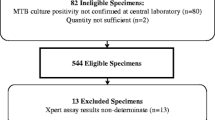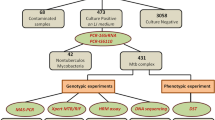Abstract
The aim of this study was to evaluate the modified rifampin oligonucleotide (RIFO) macroarray method to detect mutations in the hot-spot region of the rpoB gene, associated with rifampin (RIF) resistance in Mycobacterium tuberculosis. The study sample included 123 strains of M. tuberculosis isolated in the Beijing, China, area in 2002–2005, including 73 RIF-resistant and 40 pansusceptible strains. The genotypic assay successfully identified 91.8% of the RIF-resistant strains, whereas no mutations were found in RIF-susceptible strains. The most frequently detected rpoB mutations were in the codons 516, 526, and 531, together accounting for 74% of RIF-resistant strains. Spoligotyping subdivided all strains into 11 unique profiles and 3 profiles shared by 3, 4, and 103 strains, respectively. The 113 strains belonged to the Beijing family genotypes, defined by the specific spoligotype signature (absence of signals 1–34) and deletion of the RD105 region. The rpoB S531L (TCG→TTG) mutation was found in 57.4% of the RIF-resistant strains of the Beijing genotype. A mutation in the rpoB hot-spot region was found in 51 of the 55 (92.7%) multidrug-resistant strains (i.e., resistant to at least RIF and isoniazid), thus demonstrating the added utility of the modified RIFO method to predict multidrug resistance. The RIFO method is relatively simple to perform and allows straightforward interpretation of results; consequently, it can be used in clinical diagnostic laboratories as a fast complement to phenotypic methods.

Similar content being viewed by others
References
World Health Organization (2002) Global tuberculosis control. WHO/CDS/TB/2002.295. WHO, Geneva
Loddenkemper R, Sagebiel D, Brendel A (2002) Strategies against multidrug-resistant tuberculosis. Eur Respir J (Suppl) 36:66s–77s
Aziz MA, Wright A, De Muynck A, Laszlo A (2004) Anti-tuberculosis drug resistance in the world: third global report WHO-IUATLD. Global project on anti-tuberculosis drug resistance surveillance/global alliance for TB drug development. WHO, Geneva
Liu JJ, Yao HY, Liu EY (2005) Analysis of factors affecting the epidemiology of tuberculosis in China. Int J Tuberc Lung Dis 9:450–454
Tang S, Squire SB (2005) What lessons can be drawn from tuberculosis (TB) control in China in the 1990s? An analysis from a health system perspective. Health Policy 72:93–104
China Tuberculosis Control Collaboration (2004) The effect of tuberculosis control in China. Lancet 364:417–422
Ramaswamy SV, Musser JM (1998) Molecular genetic basis of antimicrobial agent resistance in Mycobacterium tuberculosis, 1998 update. Tuberc Lung Dis 79:3–29
Gillespie SH (2002) Evolution of drug resistance in Mycobacterium tuberculosis: clinical and molecular perspective. Antimicrob Agents Chemother 46:267–274
Telenti A, Imboden P, Marchesi F, Lowrie D, Cole S, Colston MJ, Matter L, Schopfer K, Bodmer T (1993) Detection of rifampicin-resistant mutations in Mycobacterium tuberculosis. Lancet 341:647–650
Heep M, Brandstätter B, Rieger U, Lehn N, Richter E, Rusch-Gerdes S, Niemann S (2001) Frequency of rpoB mutations inside and outside the cluster I region in rifampin-resistant clinical Mycobacterium tuberculosis isolates. J Clin Microbiol 39:107–110
McCammon MT, Gillette JS, Thomas DP, Ramaswamy SV, Graviss EA, Kreiswirth BN, Vijg J, Quitugua TN (2005) Detection of rpoB mutations associated with rifampin resistance in Mycobacterium tuberculosis using denaturing gradient gel electrophoresis. Antimicrob Agents Chemother 49:2200–2209
Ahmad S, Mokaddas E (2005) The occurrence of rare rpoB mutations in rifampicin-resistant clinical Mycobacterium tuberculosis isolates from Kuwait. Int J Antimicrob Agents 26:205–212
Cockerill FR III (1999) Genetic methods for assessing antimicrobial resistance. Antimicrob Agents Chemother 43:199–212
Victor TC, van Helden PD, Warren R (2002) Prediction of drug resistance in Mycobacterium tuberculosis, molecular mechanisms, tools and applications. IUBMB Life 53:231–237
Morcillo N, Zumarraga M, Alito A, Dolmann A, Schouls L, Cataldi A, Kremer K, van Soolingen D (2002) A low cost, home-made, reverse-line blot hybridisation assay for rapid detection of rifampicin resistance in Mycobacterium tuberculosis. Int J Tuberc Lung Dis 6:959–965
Mokrousov I, Bhanu NV, Suffys PN, Kadival GV, Yap SF, Cho SN, Jordaan AM, Narvskaya O, Singh UB, Gomes HM, Lee H, Kulkarni SP, Lim KC, Khan BK, van Soolingen D, Victor TC, Schouls LM (2004) Multicenter evaluation of reverse line blot assay for detection of drug resistance in Mycobacterium tuberculosis clinical isolates. J Microbiol Methods 57:323–335
Chinese Anti-Tuberculosis Association (1996) The laboratory science procedure of diagnostic bacteriology in tuberculosis. Zhong Guo Fang Lao Za Zhi 18:28–31
Schwoebel V, Lambregts CSB, Moro ML, Drobniewski F, Hoffner SE, Raviglione MC, Rieder HL (2000) European recommendations on surveillance of antituberculosis drug resistance. Euro Surveill 5:104–106
Kaufhold A, Podbielski A, Baumgarten G, Blokpoel M, Top J, Schouls L (1994) Rapid typing of group A streptococci by the use of DNA amplification and non-radioactive allele-specific oligonucleotide probes. FEMS Microbiol Lett 119:19–25
World Health Organization (1998) Laboratory services in tuberculosis control. Part III. Culture. WHO, Geneva, p 77
Dragon EA, Spadoro JP, Madej R (1993) Quality control of polymerase chain reaction. In: Persing DH, Smith TF, Tenover FC, White TJ (eds) Diagnostic molecular microbiology. American Society for Microbiology, Washington DC, pp 160–168
van Embden JDA, Cave MD, Crawford JT, Dale JW, Eisenach KD, Gicquel B, Hermans P, Martin C, McAdam R, Shinnik TM, Small PM (1993) Strain identification of Mycobacterium tuberculosis by DNA fingerprinting: recommendations for a standardized methodology. J Clin Microbiol 31:406–409
Kamerbeek J, Schouls L, Kolk A, van Agterveld M, van Soolingen D, Kuijper S, Bunschoten A, Molhuizen H, Shaw R, Goyal M, van Embden J (1997) Simultaneous detection and strain differentiation of Mycobacterium tuberculosis for diagnosis and epidemiology. J Clin Microbiol 35:907–914
Tsolaki AG, Gagneux S, Pym AS, Goguet de la Salmoniere YO, Kreiswirth BN, Van Soolingen D, Small PM (2005) Genomic deletions classify the Beijing/W strains as a distinct genetic lineage of Mycobacterium tuberculosis. J Clin Microbiol 43:3185–3191
Gilman J, Myatt M (1998) EpiCalc 2000. Version 1.02. Brixton Books, Brixton, UK
Bifani PJ, Mathema B, Kurepina NE, Kreiswirth BN (2002) Global dissemination of the Mycobacterium tuberculosis W-Beijing family strains. Trends Microbiol 10:45–52
Filliol I, Driscoll JR, van Soolingen D, Kreiswirth BN, Kremer K, Valetudie G, Dang DA, Barlow R, Banerjee D, Bifani PJ et al (2003) Snapshot of moving and expanding clones of Mycobacterium tuberculosis and their global distribution assessed by spoligotyping in an international study. J Clin Microbiol 41:1963–1970
Ferdinand S, Valetudie G, Sola C, Rastogi N (2004) Data mining of Mycobacterium tuberculosis complex genotyping results using mycobacterial interspersed repetitive units validates the clonal structure of spoligotyping-defined families. Res Microbiol 155:647–654
Cavusoglu C, Hilmioglu S, Guneri S, Bilgic A (2002) Characterization of rpoB mutations in rifampin-resistant clinical isolates of Mycobacterium tuberculosis from Turkey by DNA sequencing and line probe assay. J Clin Microbiol 40:4435–4438
Mokrousov I, Otten T, Vyazovaya A, Limeschenko E, Filipenko M, Sola C, Rastogi N, Steklova L, Vishnevsky B, Narvskaya O (2003) PCR-based methodology for detecting multi-drug resistant strains of Mycobacterium tuberculosis Beijing family circulating in Russia. Eur J Clin Microbiol Infect Dis 22:342–348
Mokrousov I, Otten T, Vishnevsky B, Narvskaya O (2003) Allele-specific rpoB-PCR assay to detect rifampin resistant Mycobacterium tuberculosis in sputum smears. Antimicrob Agents Chemother 47:2231–2235
Jou R, Chen HY, Chiang CY, Yu MC, Su IJ (2005) Genetic diversity of multidrug-resistant Mycobacterium tuberculosis isolates and identification of 11 novel rpoB alleles in Taiwan. J Clin Microbiol 43:1390–1394
Heep M, Beck D, Bayerdorffer E, Lehn N (1999) Rifampin and rifabutin resistance mechanism in Helicobacter pylori. Antimicrob Agents Chemother 43:1497–1499
Severinov K, Soushko M, Goldfarb A, Nikiforov V (1993) Rifampin region revisited. New rifampin-resistant and streptolydigin-resistant mutants in the beta subunit of E. coli RNA polymerase. J Biol Chem 268:14820–14825
Reynolds MG (2000) Compensatory evolution in rifampin-resistant Escherichia coli. Genetics 156:1471–1481
Billington OJ, McHugh TD, Gillespie SH (1999) Physiological cost of rifampin resistance induced in vitro in Mycobacterium tuberculosis. Antimicrob Agents Chemother 43:1866–1869
Sola C, Filliol I, Legrand E, Mokrousov I, Rastogi N (2001) Mycobacterium tuberculosis phylogeny reconstruction based on combined numerical analysis with IS1081, IS6110, VNTR, and DR-based spoligotyping suggests the existence of two new phylogeographical clades. J Mol Evol 53:680–689
Baker L, Brown T, Maiden MC, Drobniewski F (2004) Silent nucleotide polymorphisms and a phylogeny for Mycobacterium tuberculosis. Emerg Infect Dis 10:1568–1577
Glynn JR, Whiteley J, Bifani PJ, Kremer K, van Soolingen D (2002) Worldwide occurrence of Beijing/W strains of Mycobacterium tuberculosis: a systematic review. Emerg Infect Dis 8:843–849
van Soolingen D, Qian L, de Haas PE, Douglas JT, Traore H, Portaels F, Qing HZ, Enkhsaikan D, Nymadawa P, van Embden JD (1995) Predominance of a single genotype of Mycobacterium tuberculosis in countries of East Asia. J Clin Microbiol 33:3234–3238
Garcia de Viedma D, Chaves F, Inigo J; Tuberculosis Molecular Epidemiology Study Group (2006) New route of importation of Mycobacterium tuberculosis Beijing genotype. Emerg Infect Dis 12:169–170
Lopez B, Aguilar D, Orozco H, Burger M, Espitia C, Ritacco V, Barrera L, Kremer K, Hernandez-Pando R, Huygen K, van Soolingen D (2003) A marked difference in pathogenesis and immune response induced by different Mycobacterium tuberculosis genotypes. Clin Exp Immunol 133:30–37
Zhang M, Cong J, Yang Z, Samten B, Barnes PF (1999) Enhanced capacity of a widespread strain of Mycobacterium tuberculosis to grow in human macrophages. J Infect Dis 179:1213–1217
Moss AR, Alland D, Telzak E, Hewlett D Jr, Sharp V, Chiliade P, LaBombardi V, Kabus D, Hanna B, Palumbo L, Brudney K, Weltman A, Stoeckle K, Chirgwin K, Simberkoff M, Moghazeh S, Eisner W, Lutfey M, Kreiswirth B (1997) A city-wide outbreak of a multiple-drug resistant strain of Mycobacterium tuberculosis in New York. Int J Tuberc Lung Dis 1:115–121
Narvskaya O, Otten T, Limeschenko E, Sapozhnikova N, Graschenkova O, Steklova L, Nikonova A, Filipenko ML, Mokrousov I, Vyshnevskiy B (2002) Nosocomial outbreak of multidrug-resistant tuberculosis caused by a strain of Mycobacterium tuberculosis W-Beijing family in St. Petersburg, Russia. Eur J Clin Microbiol Infect Dis 21:596–602
Cox HS, Kubica T, Doshetov D, Kebede Y, Rüsch-Gerdess S, Niemann S (2005) The Beijing genotype and drug resistant tuberculosis in the Aral Sea region of Central Asia. Respir Res 6:134
Qian L, Abe C, Lin TP, Yu MC, Cho SN, Wang S, Douglas JT (2002) rpoB genotypes of Mycobacterium tuberculosis Beijing family isolates from East Asian countries. J Clin Microbiol 40:1091–1094
Tracevska T, Jansone I, Baumanis V, Marga O, Lillebaek T (2003) Prevalence of Beijing genotype in Latvian multidrug-resistant Mycobacterium tuberculosis isolates. Int J Tuberc Lung Dis 7:1097–1103
Park YK, Shin S, Ryu S, Cho SN, Koh WJ, Kwon OJ, Shim YS, Lew WJ, Bai GH (2005) Comparison of drug resistance genotypes between Beijing and non-Beijing family strains of Mycobacterium tuberculosis in Korea. J Microbiol Methods 63:165–172
van Rie A, Warren R, Mshanga I, Jordaan AM, van der Spuy GD, Richardson M, Simpson J, Gie RP, Enarson DA, Beyers N, van Helden PD, Victor TC (2001) Analysis for a limited number of gene codons can predict drug resistance of Mycobacterium tuberculosis in a high-incidence community. J Clin Microbiol 39:636–641
Hillemann D, Kubica T, Agzamova R, Venera B, Rusch-Gerdes S, Niemann S (2005) Rifampicin and isoniazid resistance mutations in Mycobacterium tuberculosis strains isolated from patients in Kazakhstan. Int J Tuberc Lung Dis 9:1161–1167
Mokrousov I, Filliol I, Legrand E, Sola C, Otten T, Vyshnevskaya E, Limeschenko E, Vyshnevskiy B, Narvskaya O, Rastogi N (2002) Molecular characterization of multiple-drug-resistant Mycobacterium tuberculosis isolates from north-western Russia and analysis of rifampin resistance using RNA/RNA mismatch analysis as compared to the line probe assay and sequencing of the rpoB gene. Res Microbiol 153:213–219
Hillemann D, Kubica T, Rusch-Gerdes S, Niemann S (2005) Disequilibrium in distribution of resistance mutations among Mycobacterium tuberculosis Beijing and non-Beijing strains isolated from patients in Germany. Antimicrob Agents Chemother 49:1229–1231
Acknowledgements
We thank Alessandra “Gucki” Riva for critical reading of the manuscript and language corrections. I.M. and W.W.J. contributed equally to this study.
Author information
Authors and Affiliations
Corresponding authors
Rights and permissions
About this article
Cite this article
Mokrousov, I., Jiao, W.W., Sun, G.Z. et al. Evaluation of the rpoB macroarray assay to detect rifampin resistance in Mycobacterium tuberculosis in Beijing, China. Eur J Clin Microbiol Infect Dis 25, 703–710 (2006). https://doi.org/10.1007/s10096-006-0215-y
Published:
Issue Date:
DOI: https://doi.org/10.1007/s10096-006-0215-y




